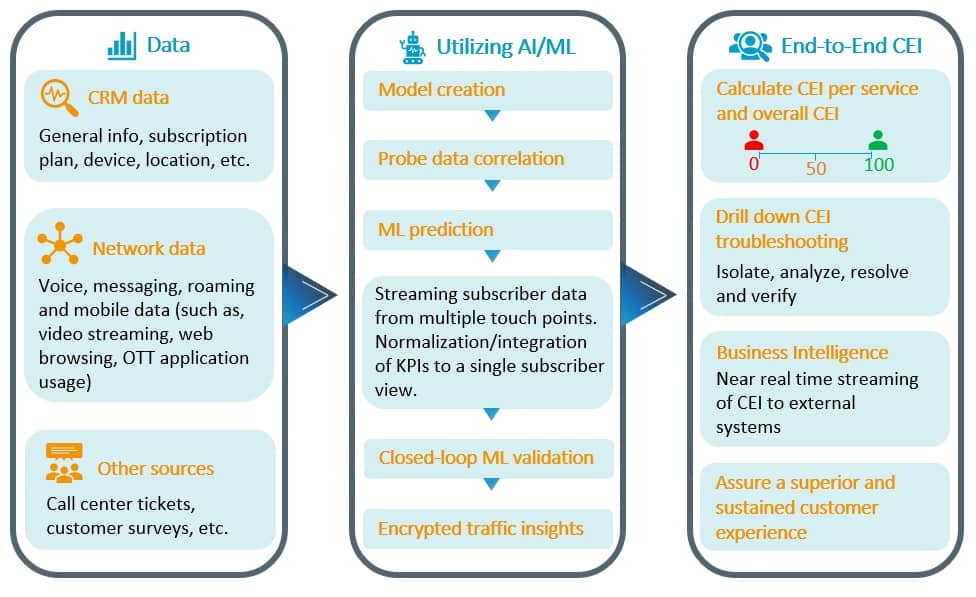Introduction: Measure Network Performance Through Customers’ Eyes
The telecom industry’s key to success is ensuring a seamless and consistent customer experience (CX) across every touchpoint, and operators are continuously adjusting to address the challenges this presents. Today’s customers do not just buy a product or a service from operators; they buy an experience. As operators globally are increasing their CAPEX spent on technologies and network development for 5G, it is crucial to show tangible returns on those investments by providing an improved and sustained customer experience. Forming that linkage is essential as competition is increasing and all are competing for the same customer.
This explosion in competition has led to increased customer churn, with operators needing to invest more effort in retaining customers. Yet, the price for delivering services to those customers has remained the same, leading to stagnant revenues. In this saturated, ultra-competitive marketplace, exceptional customer experience is becoming the primary differentiation among service providers as consumers develop new service expectations as quickly as ever.
From broadband users streaming their ever-changing Netflix series to the 5G mission-critical use cases of industry 4.0, with automated production processes, telehealth services, or AR/VR. The number of devices connecting to the network is increasing exponentially. As a result, successful operators must depend on advanced insights based on an AI-powered Customer Experience Index (CEI) to measure and analyze the true customer experience. Thus, making sense of billions of data transactions and allowing the operator to take corrective action before network performance issues turn into issues that impact customer experience.
How to Achieve an Improved Customer Experience?
Forrester, a research and advisory company, indicates that the telecom industry has the third-highest potential for increasing revenue by improving customer experience. Furthermore, by increasing their customer experience scores by only one point, operators will generate more than 1 billion USD in per-customer incremental revenue[i].
In essence, customer experience encompasses every aspect of the end-users’ interaction with the network. In order to improve the customer experience, as an operator, you must shift from network-focused indicators to customer-focused indicators. A Customer Experience Index (CEI) enables operators to understand “customer experience” from your subscribers’ point of view by capturing network and non-network data, such as surveys and call center data, and analyzing it. To identify what impacts the overall customer experience, operators define a specific CEI for their essential services. Each CEI portrays the overall experience a subscriber has with the network by correlating, measuring, and calculating customers’ specific services data throughout their interaction with the network.
Services such as voice calls (VoLTE, 5G), messaging, roaming, and mobile data – including video streaming, web browsing, OTT application usage – each have their own CEI that is based on a dynamic set of KPIs. For example, the CEI for the WhatsApp service needs to consider KPIs for audio and video calls and file transfers (such as videos and images). This includes having CEIs for 5G services, including a subscriber’s ability to connect from a 4G to a 5G cell and monitor CEIs of 5G NSA to a full deployment of 5G SA.
After collecting the data, various thresholds are applied to each specific service and further normalized based on their importance to the overall customer experience. Then, each service is weighted against each other, and the CEI is calculated for each end-user. The CEI can be seen at an individual subscriber level (for Customer Care) and, at the same time, for the entire network. Thus, it is possible to compare the individual subscriber score with the whole network’s average score.
Following the trend and distribution of customers according to the calculated CEI, operators can understand the perceived quality difference against the measured quality and, using ML and AI, adjust the KPIs and weights for each service to build a more reliable CEI. Therefore, CEIs enable you to establish an accurate satisfaction benchmark that can be used to evaluate customers’ experience across their entire journey through the network.
How can you enhance the deployed CEIs with AI and ML? And how should you address the fact that most of today’s network data traffic is encrypted?
Design an Improved CEI with Probe-Based Data
It’s impossible to calculate the CEIs for each service without probe-based data. To better understand the customer experience through your subscribers’ eyes, you must first gain service-level awareness. For example, if the subscriber is trying to watch streaming video on a device which requires sustained throughput and is now suffering from cell congestion or bad coverage; In this case, monitoring the resource and network layer is not enough. To understand why the video is not streaming adequately, we need to see the end-to-end service layer.
Operators can gain maximum visibility by integrating a probe layer into their assurance strategy, allowing them to understand the end-to-end service quality, including real-time subscriber analytics and providing troubleshooting tools. In essence, probes watch all the traffic that flows through the network and filter out individual transactions to compute the service quality experienced by each call or data transfer. They provide granular data that allows you to determine the service quality at a per-service (QoS) and per-user (QoE) granularity across multiple transport technologies.
Integrating a probe-based solution will enable you to enrich the entire network analytics to comprehend service quality from RAN to the core by improving CEI datasets. Troubleshooting a customer-affecting issue can be performed via a drill-down from the KPI layer right through to the individual network packet.
AI/ML Enhanced CEIs for Encrypted Data Traffic
The use of network traffic encryption is on the rise, with 96% of today’s world’s top 100 sites defaulting to HTTPS[ii], with a significant portion of encrypted traffic originates from Over-The-Top (OTT) services and applications (such as Netflix and YouTube). When data is encrypted, it is difficult to understand service quality. Operators cannot inspect and optimize traffic, and therefore issues impacting customers can occur and go unnoticed by the operator. This negatively impacts the CEIs for each service.
By integrating a built-in AI and machine learning (ML) assurance solution that correlates the data collected by the probes, operators can gain insights into encrypted data traffic. Designed with a sophisticated set of ML algorithms that use the network and non-network data, it can smartly define services CEIs for the entire subscriber base. The key benefits for operators are:
- Segment end-users across clearly identified KPI-based categories indicate the level of satisfaction of their experience with the service provider.
- Drill-down (end-users, locations, etc.) and serve multiple stakeholders of the service provider organization, with root cause analysis down to the subscriber level, enabling proactive corrective actions.
- Create a comprehensive model for calculating critical services CEIs for encrypted data traffic.
Therefore, when observing a low CEI, an AI/ML advanced solution enables you to perform root cause analysis down to the subscriber level, detecting and resolving issues. For example, if a dropped-call rate occurs, you can identify which locations, devices, end-users and how many of them were impacted. Following this, you can isolate the cause of the problem, analyze data patterns and implement corrective actions, thus, improving the low CEI rate and thus, leading to a higher customer experience. Moreover, in the future, it will be possible to predict and calculate a decrease in CEI based on an AI/ML solution, preventing in advance negatively impacting customer experience issues. As a result, by deploying enhanced CEIs, operators will be able to improve their customers’ retention rates while using the retrieved data to explore new revenue opportunities.

Summary
In conclusion, to achieve an improved customer experience across the entire network, operators should integrate a probe-based, AI-powered assurance solution, enhancing their existing customer experience index. Hence, the data collected from network and non-network sources is analyzed and translated into corrective actions to upgrade the perceived experience, impacting customers’ lifetime value and retention rates.
Designing and deploying enhanced CEIs is part of our advanced assurance solution, RADCOM ACE, which can enable operators to increase customers’ satisfaction rates. With a built-in AI/ML framework, our solution provides uniquely actionable insights down to every customer or packet level. The data is collected on a single subscriber basis with detailed drill-down capabilities, preventing in advance negatively impacting customer issues. Thus, making sense of billions of data transactions and assuring a superior customer experience across the entire network.
To learn more about RADCOM ACE for designing enhanced CEIs, download our white paper about AI Driven-Assurance for 5G.
[i] https://go.forrester.com/blogs/improving-customer-experience-by-1-point-can-drive-more-than-a-billion-dollars-in-revenue-in-2019/
[ii] https://transparencyreport.google.com/https/overview?hl=en


